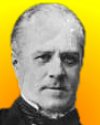 (source)
(source)
|
Julius Thomsen
(16 Feb 1826 - 13 Feb 1909)
Danish chemist who tabulated numerous colorimetric measurements. He invented a process for the production of soda from the mineral cryolite. Thomsen designed the modern format of groups and periods on the long form of the Periodic Table of the Elements, and predicted the existence of the group of unreactive gases.
|
Julius Thomsen
The Danish chemist, Julius Thomsen (1826-1909) was born the son of a bank auditor, in Copenhagen, Denmark on 16 February 1826. His academic life also centred around Copenhagen. His master's degree was from the University of Copenhagen (1843), where he then joined the faculty teaching chemistry, becoming a professor in 1866.
He was also active in the community, as a member of the city's Municipal Council for thirty-five years. In this capacity, he brought about significant improvements in the city's water, gas and sewage utilities.
THOMSEN AND PERIODICITY OF THE ELEMENTS
Julius Thomsen first suggested the modern long form layout of the Periodic Table. He indicated that the periods - horizontal rows - should each end at an element of valency zero, namely those elements now known as the noble gases.
This is described by Sir Edward Thorpe in History of Chemistry, Vol II, From 1850 to 1910, pp 51-52 (G. P. Putnam's Sons, London, 1910).
Thomsen was born the son of a bank auditor, in Copenhagen, Denmark on 16 February 1826. His academic life also centred around Copenhagen. His master's degree was from the University of Copenhagen (1843), where he then joined the faculty teaching chemistry, becoming a professor in 1866.
He was also active in the community, as a member of the city's Municipal Council for thirty-five years. In this capacity, he brought about significant improvements in the city's water, gas and sewage utilities.
THOMSEN, THERMOCHEMISTRY AND THE DAVY MEDAL
The thermochemical measurements he made were done independently of, but paralleled, the work of French chemist Marcelin Berthelot. Thomsen carefully measured and made tables of the amount of heat released or absorbed in approximately 3,500 chemical reactions.
Thomsen (like Berthelot) regarded the release of heat to be the driving force of a chemical reaction. Although we now know this is a flawed generalization, it seemed plausible to them from observing chemical reactions that readily released heat (exothermic reactions). Thus they recognized chemical reactions as either “spontaneous” or “not spontaneous” according to their transfer of heat.
A spontaneous chemical reaction would be one that moved in only one direction and would give off heat while doing so. Conversely, if such a reaction were to be forced into reverse, it would be necessary to absorb heat. (Lavoisier and Laplace were the first to hold such views).
For example, hydrogen and oxygen combine to form water, and conversely, water can decompose into hydrogen and oxygen. The formation of water gives off a great deal of heat very rapidly, even explosively. Such a reaction would be regarded as spontaneous, since once started, it goes rapidly to completion.
Conversely, for water to decompose into hydrogen and oxygen requires an input of energy (such as heat or electricity). The breakdown of the water molecule would be regarded as not spontaneous, since it is not seen to occur at all until there is a continuous supply of energy and once started, the reaction ceases immediately without the energy input.
As it would be recognized by later workers, such a simplified view of chemical reactions is incorrect for two reasons.
2. There are reversible reactions. Thus, substances A and B can react spontaneously and be converted to substances C and D, while C and D can, just as spontaneously, react back to A and B. Such reactions are indicated with reversible arrows:
It still remained for other chemists to recognize that it is the influence of concentration - not even just the different masses of the reactants present - that determines chemical kinetics.
In 1883, the Davy Medal was awarded in duplicate, to “M. Marcellin Berthelot, Member of the Institute of France, and Foreign Member of the Royal Society, and Prof. Julius Thomsen, of Copenhagen." This award was described in his Presidential Address by Professor Huxley to the Royal Society, 30 Nov 1883, (printed in Nature, Dec 1883):
“The labours of Messrs. Berthelot and Thomsen have done much towards supplying that want, and they will be of the utmost value for the advancement of chemical science.”
THOMSEN AND ACID STRENGTHS
Thomsen was the first to make measurements of the relative strengths of acids.
THOMSEN AND CRYOLYTE
Thomsen was also adept at applied chemistry. In 1853, he patented a process to manufacture sodium carbonate from the mineral cryolite (Na3AlF6, sodium aluminum fluoride).
At the time, this mineral was found only on west coast of Greenland, a Danish colony, and had no other practical use. He became prosperous from the proceeds of this patent.
(Later, in 1886, the American chemist Charles Hall was to use this mineral in the first inexpensive method to produce aluminium from its oxide in bauxite ore, with an electrolytic process utilizing molten cryolite to dissolve the aluminium oxide. Modern production of alumium uses artificially synthesized sodium aluminum fluoride, since the mineral is in relatively short supply compared to the huge tonnage of the metal now processed.)
- 16 Feb - short biography, births, deaths and events on date of Thomsen's birth.





